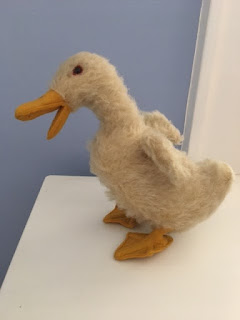This first pick will have you singing the blues - in the best way possible. This is lot #1704, a blue tipped circus elephant with a starting bid of 650 euro. It is cataloged as:
"Circus elephant, mohair plush, grey/blue flamed, jointed, with neck mechanism and snap joints, velvet paws with toes, with felt down below of the snout and also at the point of the trunk, blue glass eyes, 32 cm, there is no snap mechanism in the snout, the elephant was X-rayed at Steiff, many parts of the mechanism are identical to the subsequent serial model, this is a test version, it is known that a similar elephant was in possession of the family Steiff (Klara Steiff, great second cousin Magarete Steiff) and a few years before it returned to the Steiff-archive, after that was a replica produced with red flamed mohair, in Giengen it was common practice that this test models were presented to relatives of employees or on the occasion of special events, version without tusks, small places with pelt loss, this version isn't listed in the Pfeiffer catalog."
And just what makes this petite pachyderm so unforgettable? It is always thrilling to learn of one of a kind Steiff treasures, and it is clear to see where this particular model fits in with the company's line of "snap" models. These high end novelties had spring joints and were designed to have movement and snap back and forth into different playful positions. Snap jointing could appear on an item's hands, feet, legs, and mouth. Original Steiff snap style items are all extremely rare to begin with, so to find a sample or prototype of one is really extraordinary. Standard line models produced included a Snap Dicky, a Snap Circus Bear, this general style of Snap Elephant, and a little known doll with snap jointing in her legs, enabling her to stand or sit easily. All of these variations were produced in the 1930's.
The blue mohair color of this sample is also very interesting. Steiffgal can only think of a handful of standard line prewar Steiff mohair items were produced in blue - including a few novelty rabbits and dogs. It is possible that this item was not produced in blue was because blue mohair was expensive, challenging to work with, or just not available on a commercial scale.
"Record orang-utang, No. 320, 1929 - 1933, mohair, felt face, glass eyes, 18 cm, with button, felt is except of minimally places in face and a small place at one hand in good condition, good mohair, the color on the wheels is worn, rare, voice is faulty."
This monkey on the go is the wheel-deal indeed. A few details about this item are certain to send collectors on a joy ride. The first, of course, is his form. Orangutangs are extremely rare in the early Steiff line. The most familiar pre-war version is the company's playful and very appealing Mimocculo. This great pattern was produced in 11 sizes ranging from 8 to 50 cm from 1930 through 1936 overall. The middle and larger sizes featured a most unusual "pull the ear and the eyeballs move" feature. In 2010, a 13.5 cm example sold for close to $10,000 at an auction at Christies in London.
The second is the fact that this first class example rides upon a four wheeled "Irish Mail Cart." This means that the carriage appears to be propelled by the rider pumping a handlebar back and forth with their arms. These "record" style animals on carts were introduced in 1912 and were an immediate hit. Bears, rabbits, monkeys, felt novelty dolls, and even Felix the Cat and Mickey Mouse appeared on these rolling carts. It is easy to understand why early items on working carriages seem to always drive auction bidders into fifth gear!
"Caricature figure, Hungarian, produced between 1912 - 1917, felt, jointed, national costume, item description "Ung 50 Völkertypen", shoe button eyes, traditional costume and also head with holes in the felt, original leather shoes with tassels, nailed shoes, c. 50 cm, without hat, left arm is mended and also a small red felt insert, otherwise good condition, rare."
This fine example has uniform appeal, especially among the small army of Steiff military doll enthusiasts. Steiff’s uniformed dolls were a significant percentage of the company’s line and business in the early part of the 20th century. All of these dolls had most or all of their clothing integral to their bodies and were five ways jointed; some 50 cm and larger also had jointed knees. In a span of about 20 years, Steiff produced examples representing German, Scottish, Moroccan, Turkish, Dutch, Russian, American, Belgian, French, Italian, Hungarian, and Austrian armed forces, among others. All were known for their well tailored and authentic clothing, extraordinary to-scale accessories, and, of course, their perfect posture. Check out this soldier's fantastic jacket buttons and embroidery as well as the tiny tassels on his well constructed boots! Steiff made over 100 distinctly designed military dolls over time; most of these patterns were made in two or three sizes each. In tribute to some countries, like Germany, England, and the United States, Steiff produced dolls at numerous ranks and in various uniform types.
Steiffgal hopes this auction preview tour has been a highlight of your day! And good luck if you do bid on any of the sale's fantastic treasures!
Have a question about one of your Steiff treasures? Let's talk! Click here to learn more.




















